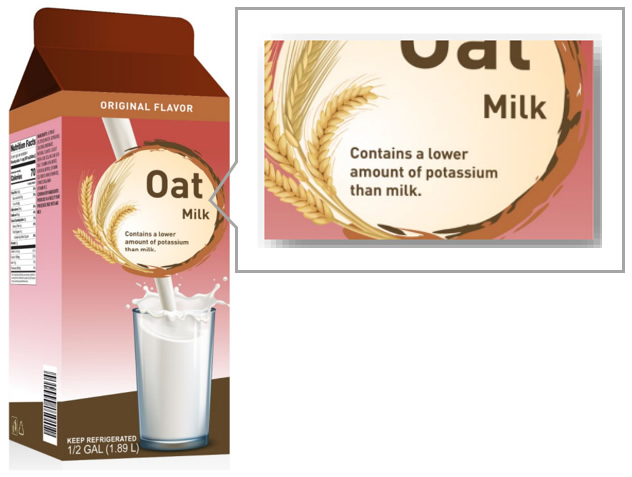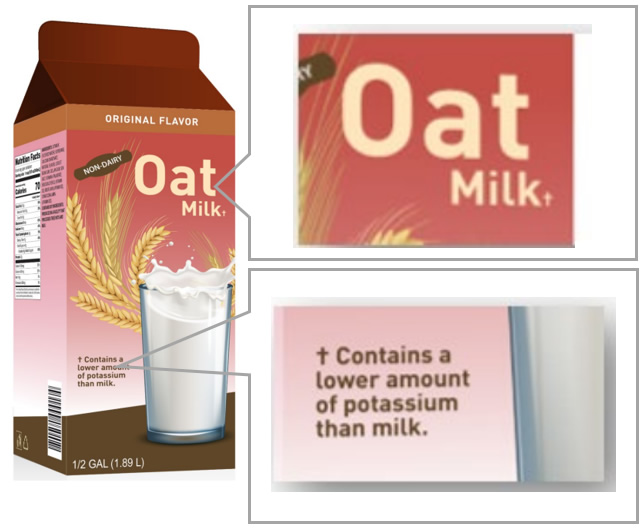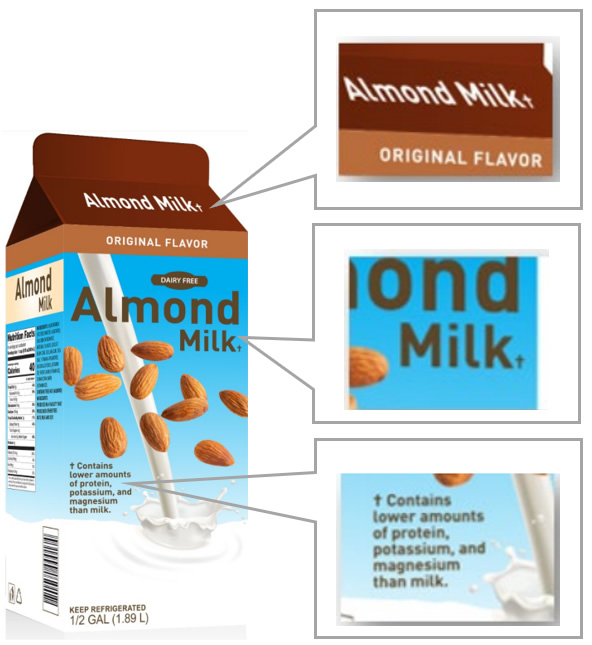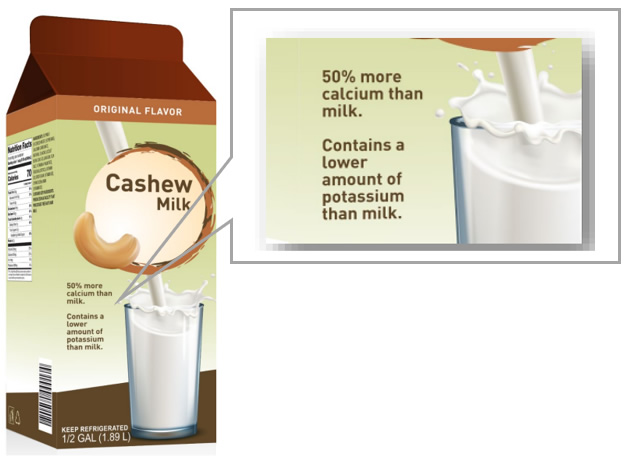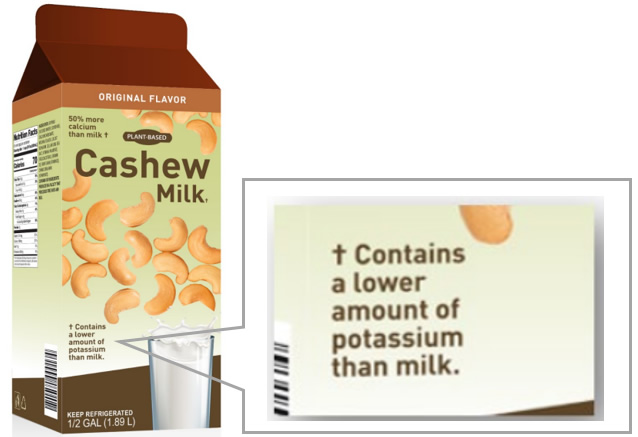
Note: This article is related to a foreign regulation (United States of America). For more articles regarding Japanese regulations please refer to our newsletter page.
On February 22, 2023, the U.S. Food and Drug Administration (FDA) issued the draft guidance to ensure appropriate labeling of plant-based milk alternatives (PBMA) sold as substitutes for milk and requested public comments.
The draft guidance explains (1) Identity and Names (2) Recommendations for Voluntary Nutrient Statements in a Q&A format. Here we would like to take up some excerpts. Consumers should be able to easily identify the nature of a food product with regard to the naming of plant-based milk alternatives. The labeling methods are explained below.
(1) Identity and Names
Regarding the naming of plant-based milk alternatives, it is important to ensure that consumers can easily recognize the nature of the food. The labeling method is explained below.
(*The below is a summary from the guidance. See the reference for details.)
1.1. Is there an established standard of identity for plant-based milk alternatives?
No, plant-based milk alternatives are non-standardized foods as no definition or standard of identity has been prescribed for them by regulation.
1.2. What are the common or usual names of plant-based milk alternatives?
Common or usual names have been established by common usage for some plant-based milk alternatives. Among these names are “soy milk” and “almond milk” and others that qualify the term “milk” with the plant source of the food. Names that qualify the terms “beverage” or “drink” with the plant source of the food are used less frequently, but also appear to be in common usage. These names include “soy beverage” and “almond beverage.”
1.3. Do plant-based milk alternatives need to include the term “milk” in their names (e.g., “soy milk,” “almond milk,” etc.)?
No. Non-standardized foods are required to be labeled with their common or usual name if such a name exists. As explained in 2, many plant-based milk alternatives appear to have multiple common or usual names. Under the FD&C Act, plant-based milk alternatives must be labeled with a common or usual name, but there is no requirement that they be labeled with more than one common or usual name. Consequently, a plant-based milk alternative may be labeled with the term “beverage,” “drink,” or “milk.”
1.4. How should the term identifying the plant source appear in reference to the term “milk,” “beverage,” or “drink”?
In the names of plant-based milk alternatives, the term “milk” (or “beverage” or “drink”) should be qualified by the plant source of the food. The name may be a single word (i.e., “soymilk”), multiple words (e.g., “soy milk”), or hyphenated (e.g., “soy-milk”).
1.5. Is “plant-based milk” an appropriate name for plant-based milk alternatives?
No, while “plant-based” or “plant” may be used to describe a plant-based milk alternative, we do not recommend using only these terms in the name of the food. “Plant-based milk” is not the common or usual name of plant-based milk alternatives.
Moreover, omitting a descriptor of the particular legume, nut, grain, seed, or other plant source in the name of the food may be confusing to consumers, as the product would not be readily distinguishable from other types of plant-based milk alternatives. The nature or source of the characterizing or predominant ingredients is important information for consumers and should be included in the name or statement of identity to identify and describe the food and distinguish it from similar foods. Consumers should be able to easily determine the particular plant source when looking at the name of the food on the label (e.g., almond or oat).
1.6. How should plant-based milk alternatives that are blends of different plant sources be labeled?
If a plant-based milk alternative is derived from different plant sources, we recommend that the different plant sources be included in the name so that consumers can easily identify the nature of the food and distinguish it from similar foods. We recommend that the predominant plant source be stated first in the name or statement of identity. For
example, a plant-based milk alternative that is a blend of walnuts and cashews, with walnuts predominating, should be labeled with “walnut” first, followed by “cashew”;
possible names include: “Walnut & Cashew Milk,” “Walnutmilk with Cashew milk,” or “Walnut-Cashew Milk.”
For plant-based milk alternatives that are blends of two or more plant-sources, the name should accurately convey to the consumer that multiple plant sources are present.
For example:
– “Soy and Nut Milk Blend” (for a product that contains a blend of soy, almonds, and cashews)
– “7 Grain Plant-Milk Blend” (for a product that contains a blend of only grains (e.g., oats, wheat, barley, rice)) All plant sources must be declared in the ingredient statement.
1.7. Should plant-based milk alternatives be labeled “imitation milk”?
FD&C Act has defined an imitation food as one that substitutes for and resembles another food and is nutritionally inferior to that food.
Not all plant-based milk alternatives meet this definition, but to the extent they do, so attentions should be paid to ensure that they are not considered misrepresented.
The information we reviewed demonstrates that consumers generally do not mistake plantbased milk alternatives as milk, understand that they are distinct products, and often purchase plant-based milk alternatives because they are not milk (e.g., lactoseintolerance, vegan diet).
1.8. Should plant-based milk alternatives be labeled as “dairy-free” or “non-dairy”?
The use of truthful and not misleading label statements (e.g., “dairy-free,” “non-dairy”) that help inform consumers that the products are derived from plants, and are not milk and do not contain milk, is encouraged. However, the term “dairy-free milk” is not an adequate name for any plant-based milk alternative because it does not describe the nature of the plant-source and therefore does not distinguish the product from other types of plant-based milk alternatives. The nature or source of the characterizing or predominant ingredients is important information for consumers and should be included in the name or statement of identity to identify and describe the food and distinguish it from similar foods. Thus, such terms are not appropriate names for plant-based milk alternatives but may be used as additional information on product labels to help inform consumers that the products are not made with dairy or milk.
(2) Recommendations for Voluntary Nutrient Statements
FDA recommends that plant-based milk alternatives that have a different nutrient composition than milk be labeled to bear an additional nutrient statement on the product label describing how it is nutritionally different.
(*The below is a summary from the guidance. See the reference for details.)
2.1. What is the purpose of voluntary nutrient statements for plant-based milk alternatives?
FDA recommends the use of these statements to help consumers understand certain nutritional differences between milk and plant-based milk alternatives that use the term “milk” in their name (e.g., “soy milk,” “almond milk,” “oat milk,” “almond-macadamia milk blend,” etc.) and have a nutrient composition that is different than milk. As discussed above, milk plays an important role in healthy diets, and the Dietary Guidelines encourage increased consumption of milk to help alleviate specific nutrient shortfalls.
Additionally, consumer research indicates that, while the majority of consumers understand that milk and plant-based milk alternatives are different products, consumers may not understand the nutritional differences between them. Consumer research also indicates that consumers perceive plant-based milk alternatives labeled with the term “milk” to have a more favorable nutritional profile than similar products labeled with terms like “drink” or “beverage”.
2.2. How should manufacturers determine if their plant-based milk alternatives have different nutrient compositions to milk?
To determine if a plant-based milk alternative is nutritionally different than milk, FDA recommends using USDA’s FNS fluid milk substitutes nutrient criteria.
(See Appendix 1 of the draft guidance)
2.3. What information does FDA recommend be included in the voluntary nutrient statement?
For plant-based milk alternatives that have a different nutritional composition than milk, labeling as follows is recommended as the example shown below.
– Contains lower amounts of [nutrient name(s)] than milk.
2.4. How does FDA recommend the voluntary nutrient statement be presented on the label?
Placing the voluntary nutrient statement on the principal display panel (PDP) near and visually connected to the name of the product is recommended if space allows. A symbol (e.g., , “†”) may be placed next to the name of the product that directs consumers to the voluntary nutrient statement on the PDP. It is also recommended the voluntary nutrient statement be prominent on the food label so that it is easily identifiable for consumers.
2.5. Why does FDA recommend certain plant-based milk alternatives bear additional information on their label when nutrition information is already provided in the Nutrition Facts label?
To provide consumers with additional information about how a plant-based milk alternative may be nutritionally different than milk when they purchase and consume it.
2.6. If my plant-based milk alternative contains the same amount of nutrients of public health concern as milk, but has lower levels of magnesium, which is not under-consumed, does FDA recommend that my product still bear a voluntary nutrient statement?
Yes, labeling such as the example below is recommended.
– Contains a lower amount of magnesium than milk.
2.7. The name “Almond Milk” appears in multiple places on the label of my plant-based milk alternative that does not have a similar nutrient composition as milk. Does FDA recommend that there be a voluntary nutrient statement or a symbol leading to a voluntary nutrient statement next to all the uses of “Almond Milk” on the label?
FDA recommends a voluntary nutrient statement or a symbol (e.g., “†”) leading consumers to the voluntary nutrient statement on the PDP be placed next to the product name when it appears on the PDP, but not necessarily when it appears in other places on the label.
2.8. May plant-based milk alternatives that have a nutrient composition that is different than milk bear a relative claim comparing the product to milk?
Yes. Currently, some plant-based milk alternatives make relative claims as follows e.g., “50% more calcium than milk,” “contains similar amounts of calcium as milk” However, some products may contain lower amounts of other important nutrients found in milk. In these scenarios, we recommend that a voluntary nutrient statement or a symbol leading consumers to the voluntary nutrient statement on the PDP be placed next to such relative claims. FDA also recommend that the voluntary nutrient statement be as prominent on the food label as the relative claim so that it is easily identifiable for consumers.
2.9. May a manufacturer make a statement about other nutrients not in USDA’s FNS nondairy beverages nutrient criteria or about higher amounts on the label?
Yes, manufacturers may make truthful and not misleading statements about nutrients.
e.g.
– Contains 20% more of the Daily Value for iron than milk.
– Contains 50% more calcium than milk.
2.10. If a plant-based milk alternative is named “Soy Beverage” and it bears a relative claim comparing the product to milk, does FDA recommend that it bear a voluntary nutrient statement?
Yes.
2.11. Does FDA recommend that the added sugars content of plant-based milk alternatives be communicated to consumers in the voluntary nutrient statement?
No, labeling of the added sugars content for voluntary nutrient statements is not recommended.
2.12. Do the voluntary nutrient statement recommendations outlined in this guidance apply to other plant-based dairy alternatives such as plant-based cheese, yogurt, or kefir alternatives?
No, the voluntary nutrient statement recommendations outlined in this guidance are limited to plant-based milk alternatives and are not intended apply to any other foods.
From the above, as for labeling plant-based milk alternatives easily identifying differences from milk including their nutritional value is important. The draft guidance also includes consumer survey results on their perception of plant-based milk alternatives. If you are considering exporting plant-based milk alternative products to the U.S., we recommend checking the guidance.
References
- FDA Releases Draft Guidance on Labeling of Plant-Based Milk Alternatives
- Plant-Based Milk Alternatives (PBMA)
- Draft Guidance for Industry: Labeling of Plant-Based Milk Alternatives and Voluntary Nutrient Statements
Newsletter Signup
We issue monthly e-newsletters, which provide you with the latest updates on food labeling/regulations in Japan.
If you want to make sure to not miss any issue, please click below.
Related Service
Research Services on Ingredients & Food Labeling -For the Japanese Market-
We verify the conformity of ingredients and additives with the standards for use in Japan based on specifications such as formulation lists. We also verify the conformity of the proposed labeling of ingredient names, nutrients, etc. with the labeling standards based on specifications such as formulation lists.

Label bank Co., Ltd. Regulatory Review and Development
Born in Japan. Specializing in nutrition, she is engaged mainly in research on ingredients and labeling drafts for food products to be exported from Japan to overseas, as well as in checking the consistency between Japanese and overseas nutrition labeling.

